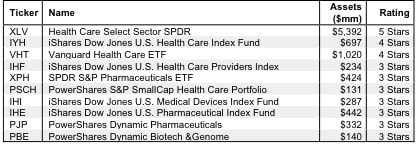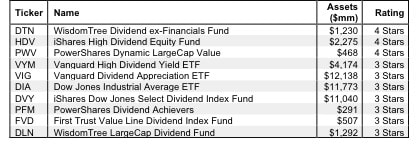This article explains how I determine the best ETFs in the 25 reports I publish each quarter on the Best & Worst ETFs and mutual funds by sector and style. Here is the 4Q Best & Worst preview. I follow these steps:
- Eliminate ETFs with inadequate (less than $100 million) assets and too much tracking error
- Determine which remaining ETFs are the best
There are several simple and free screens to perform the first step and cull out ETFs that should be avoided.
As long as you focus on the ETFs from issuers that have a market cap of at least $100 million, you are likely working with ETFs that are successful enough to garner serious assets. So, you can assume their tracking error is respectable and liquidity is high enough that you will not get thrown under the bus by the bid/ask spread.
Now comes the hard part: picking the ETF with the best holdings. Contrary to the screens above, there are very few services that evaluate the quality of the holdings of an ETF.
Research on holdings is necessary due diligence because an ETF’s performance is only as good as its holdings’ performance. No matter how cheap, if it holds bad stocks, the ETF’s performance will be bad.
PERFORMANCE OF ETF’s HOLDINGs = PERFORMANCE OF ETF
You cannot rely on the ETF label/name to accurately reflect the ETF’s holdings. ETFs with the same label often have radically different holdings. See Barron’s “The Danger Within”.
My ratings on ETFs are based primarily on my stock ratings of their holdings.
Figure 1 shows my ranking of the best ten health care ETFs with assets over $100 million. Here are my rankings on all 21 US equity health care ETFs.
I only recommend the top three ETFs in this sector: Health Care Select Sector SPDR (XLV), iShares Dow Jones U.S. Health Care Index Fund (IYH) and Vanguard Health Care ETF (VHT) because they get my 4-star or better rating. I do not recommend investors buy any ETFs with a 3-star rating or lower.
Figure 1: Top 10 Health Care ETFs
My ETF rating also takes into account the total annual costs, which represents the all-in cost of being in the ETF. This analysis is simpler for ETFs than funds because they do not charge front- or back-end loads and transaction costs are incurred directly. There is only the expense ratio, which is normally quite low. However, my ratings penalize those ETFs with abnormally high expense ratios or any other hidden costs.
Figure 2 shows my ranking of the best ten large-cap value ETFs with a market cap over $100 million based on the quality of their holdings. Here are my rankings on all 39 US equity large cap value ETFs.
Figure 2: Top 10 Large Cap Value ETFs
The best large cap value ETF is WisdomTree Dividend ex-Financials Fund (DTN). Only two other ETFs in this sector, iShares High Dividend Equity Fund (HDV) and PowerShares Dynamic LargeCap Value (PWV), earn my 4-star or Attractive rating. All the rest get my 3-star or Neutral rating and should be avoided.
The stock that shows up consistently in the top health care and large cap value ETFs is Johnson & Johnson (JNJ). This stock gets my Very Attractive rating. JNJ has a return on invested capital (ROIC) of 17%, which places it in the top quintile of all companies. Usually that kind of profitability comes at a price. In this case, the valuation of JNJ’s stock price implies the company’s profits will permanently decline by 26%. XLV’s large allocation to a highly profitable, yet undervalued stock, exemplifies why XLV is one of the few ETFs that gets a Very Attractive rating.
Another stock that shows up often in the top health care and large cap value ETFs is Verizon (VZ). VZ’s ROIC is not super high but its economic earnings growth in its last fiscal year was nearly 100% versus negative growth in reported accounting earnings. And the valuation of the stock is cheap. Its current stock price (~$46.50/share) implies the company’s profits will permanently decline by about 30%. High profit growth and low valuation create excellent risk/reward in a stock.
Disclosure: I own JNJ and VZ. I receive no compensation to write about any specific stock, sector or theme.


2 replies to "How I Find the Best ETFs"
interesed in top-performing etfs in different sectors
They are all there in the “Best & Worst ETFs by Sector” https://www.newconstructs.com/2013/05/01/2q-best-worst-etfs-mutual-funds-by-sector-recap/
Q3 version will be out starting in July